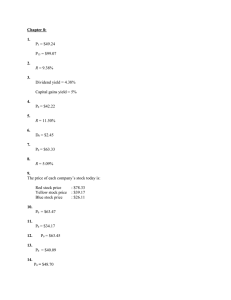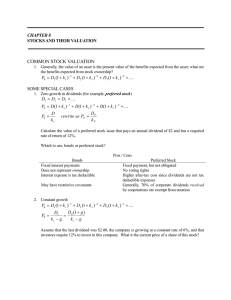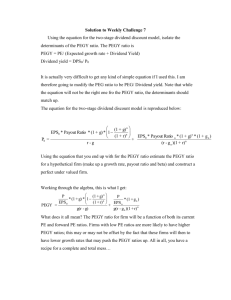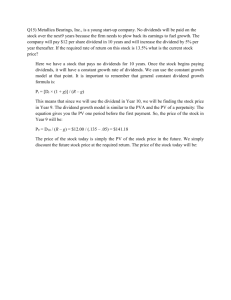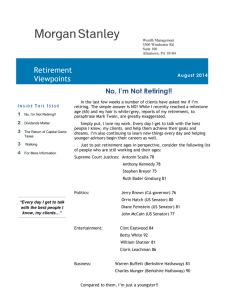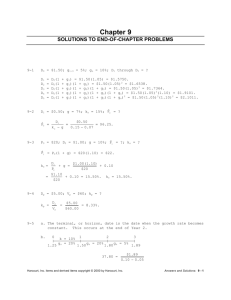ECO 4368 Instructor: Saltuk Ozerturk Common Stock Valuation
advertisement
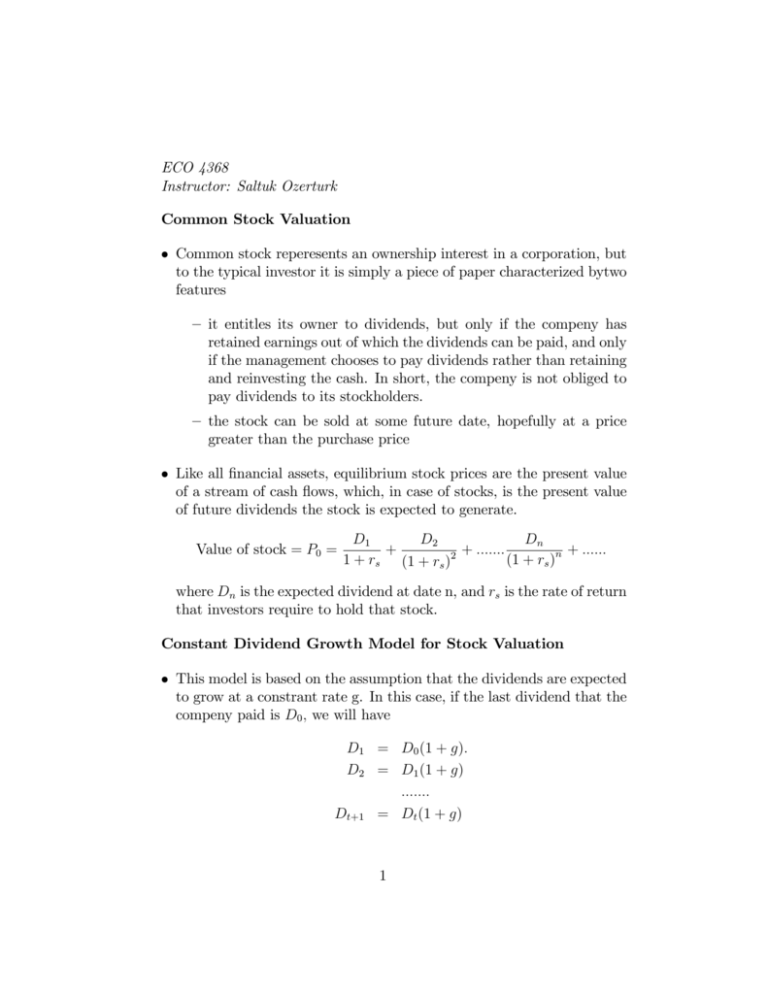
ECO 4368
Instructor: Saltuk Ozerturk
Common Stock Valuation
Common stock reperesents an ownership interest in a corporation, but
to the typical investor it is simply a piece of paper characterized bytwo
features
– it entitles its owner to dividends, but only if the compeny has
retained earnings out of which the dividends can be paid, and only
if the management chooses to pay dividends rather than retaining
and reinvesting the cash. In short, the compeny is not obliged to
pay dividends to its stockholders.
– the stock can be sold at some future date, hopefully at a price
greater than the purchase price
Like all …nancial assets, equilibrium stock prices are the present value
of a stream of cash ‡ows, which, in case of stocks, is the present value
of future dividends the stock is expected to generate.
Value of stock = P0 =
Dn
D2
D1
+
+ ::::::
2 + :::::::
1 + rs (1 + rs )
(1 + rs )n
where Dn is the expected dividend at date n, and rs is the rate of return
that investors require to hold that stock.
Constant Dividend Growth Model for Stock Valuation
This model is based on the assumption that the dividends are expected
to grow at a constrant rate g. In this case, if the last dividend that the
compeny paid is D0 ; we will have
D1 = D0 (1 + g):
D2 = D1 (1 + g)
:::::::
Dt+1 = Dt (1 + g)
1
Accordingly, the current stock value will be given by
D2
Dn
D1
+
+ ::::::
2 + :::::::
1 + rs (1 + rs )
(1 + rs )n
D0 (1 + g) D0 (1 + g)2
D0 (1 + g)n
=
+
+
:::::::
+ ::::::
1 + rs
(1 + rs )n
(1 + rs )2
P0 =
D0 (1 + g)
=
1 + rs
1+g
1+
+
1 + rs
1+g
1 + rs
2
+ :::::::
1+g
1 + rs
n
!
+ ::::
which yields
P0 =
D1
D0 (1 + g)
=
rs g
rs g
In other words, in a constant growth dividend stock model, the current
stock price is given by the next expected dividend divided by P0 divided
rs g, where rs is the required return on the stock and g is the expected
constant dividend growth rate.
Example 1: Consider a stock that just paid a dividend of $2 per share.
The investors expect the dividends to grow at a constant annual rate
g = 8%. If the investor require a rate of return of rs = 13% for holding
the compeny stock, what should be the current stock price?
Answer:
P0 =
2(1 + 8%)
D0 (1 + g)
=
= 43:2
rs g
13% 8%
Capital Gains Yield and Dividend Yield in a Constant Growth
Model:
Consider the stock price valuation formula for the constant dividend
growth model given by
D1
P0 =
rs g
This equation tells us that the stock price at date 1 is given by
P1 =
2
D2
rs
g
which implies that the percent change in the stock price from date 0
to date 1 is equal to
P1
P0
P0
=
D2
rs g
D1
rs g
D1
rs g
D2
=
D1
D1
=
D1 (1 + g)
D1
D1
=g
In other words, in a constant dividend growth model, the stock price
grows at a constant rate g equal to the dividend growth rate. Accordingly, capital gains yield for this stock is given by g:
Decomposition of the Required Return on the Stock
Again consider the stock price valuation formula for the constant dividend
growth model given by
D1
P0 =
rs g
This equation can be rewritten as
D1
rs g =
P0
D1
+g
) rs =
P0
Therefore, the required return on the stock can be decomposed into two
components
D1
rs =
+
g
|{z}
P0
|{z}
capital gains yield
dividend yield
Example 2: Consider a stock that just paid a dividend of $5 per share. The
investors expect the dividends to grow at a constant annual rate of g = 5%.
If the investor require a rate of return of rs = 10% for holding the compeny
stock, what is the expected dividend yield? What is the expected capital
gains yield?
Answer: First, …nd the current stock price as
D0 (1 + g)
$5(1 + 5%)
P0 =
=
= 105
rs g
10% 5%
Now one can …nd,
$5(1 + 5%)
D1
Dividend Yield =
=
= 5%
P0
105
Capital Gains Yield = g = 5%
3


